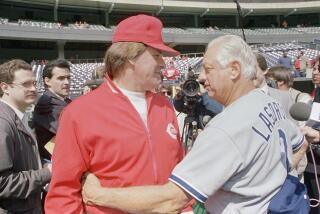Moonglows: Deserving of Hall of Fame Vote?
- Share via
Sincerely now: Do the Moonglows really belong in the Rock and Roll Hall of Fame?
That’s a question rock fans may be asking as we approach the 15th annual Hall induction dinner on March 6 in New York. Other performers scheduled to be inducted are Eric Clapton, Bonnie Raitt, James Taylor and the groups Earth, Wind & Fire and the Lovin’ Spoonful.
In addition, five other musicians--Hal Blaine, King Curtis, James Jamerson, Scotty Moore and Earl Palmer--will be inducted in a new “sidemen” category. Also to be honored: Nat King Cole and Billie Holiday in the “early influences” category and Arista Records founder Clive Davis in the “nonperformer” category.
This pushes the number of inductees well toward the 200 mark, and is sure to renew the debate over whether the Hall of Fame is inducting too many people. Should the Hall of Fame be more selective--with standards high enough to define it as a Hall of Greatness, so to speak--or should the selection process be more generous--even if that strategy reduces it to a Hall of Good?
Some of this year’s inductees definitely live up to all the qualities you’d expect in a Hall of Fame member, but there will surely be a debate over others.
The Moonglows, for instance, are a vocal group that has been passed over for 14 years by voters.
Was that a gross oversight, or are the Moonglows benefiting this year from what is a lean crop of eligible artists? Note: The voters only inducted six artists rather than the normal seven in the main performer category.
As always, the best way to weigh a particular act’s merits is to listen to the music--and a 16-track “greatest hits” album gives you all you need to cast your own vote.
*
*** “The Moonglows: Their Greatest Hits,” Chess/MCA. As Joseph F. Laredo declares in the album’s liner notes, in many of their key recordings the Moonglows combined elements of pop/R&B; tradition with a sense of the raw, teen-directed urgency and adventure that characterized ‘50s rock.
“They managed to neatly synthesize elements of the best black harmony ensembles preceding them, such as the Mills Brothers and the Ink Spots, while tempering their mentors’ smoothness with earthy, infectious shadings of rhythm and blues,” he writes, outlining, in essence, the heart of the case for the Moonglows’ place in pop-rock history. “The result was a unique, instantly identifiable sound that trumpeted the first glimmerings of the rock and roll revolution, and set a lofty standard for the untold number of classic doo-wop performances that followed in their wake.”
The group’s history began in Louisville, Ky., where members Harvey Fuqua and Bobby Lester sang together before military service pulled them apart. Later, Fuqua started a jazz-oriented singing trio, the Crazy Sounds, in Cleveland and brought Lester in as a fourth member.
Alan Freed, the legendary Cleveland DJ who championed rock ‘n’ roll, heard the group and signed it to his new record label. The group’s name was changed to the Moonglows, a nod to Freed’s radio show, “The Moondog Rock ‘n’ Roll Party.”
*
The group moved in 1954 to Chess Records, the powerful Chicago R&B; label that was also home to Chuck Berry, Muddy Waters, Howlin’ Wolf and Bo Diddley (all Rock Hall of Fame members).
The Moonglows’ first Chess single, “Sincerely,” was one of the quintessential ballads of the early days of rock ‘n’ roll. Written by Fuqua, the song is a tale of teen desperation that still resonates with convincing emotion.
It was a blockbuster in the R&B; world, though it only reached No. 20 on the pop charts because R&B; acts had difficulty getting mainstream radio exposure at the time. A far less-affecting pop version by the McGuire Sisters got the mainstream exposure that helped their record spend 10 weeks at No. 1 on the pop charts.
The greatest-hits set opens, understandably, with “Sincerely,” and includes all six of the quintet’s other Top 40 R&B; hits, including “We Go Together” (later a pop hit for Jan & Dean) and a remake of Percy Mayfield’s 1950 hit “Please Send Me Someone to Love.”
There are engaging moments in the album, whose other material ranges from the lush Doris Day hit “Secret Love” to the good-time bounce of “Let’s Go.” Ultimately, however, the music seems to fit better under the “good” rather than the “great” standard that has been met by many of the other R&B; groups that have been voted into the Rock and Roll Hall of Fame.
The Moonglows don’t display the musical ambition shown in the recordings of the Drifters, the sheer excitement of Hank Ballard’s work with the Midnighters, or the social consciousness and grace of Curtis Mayfield and the Impressions.
If you follow the Moonglows’ career further and check out “Blue Velvet/The Ultimate Collection,” a two-disc CD released by Chess/MCA, you do find a few gems, including the humorous “He Lied” and the deeply emotional “Foolish Me.” But there is still something too anonymous about the Moonglows’ music to make it seem more than merely accomplished.
*
Robert Hilburn, The Times’ pop music critic and a member of the 69-member Rock and Roll Hall of Fame nominating committee, can be reached by e-mail at robert.hilburn@latimes.com.
More to Read
The biggest entertainment stories
Get our big stories about Hollywood, film, television, music, arts, culture and more right in your inbox as soon as they publish.
You may occasionally receive promotional content from the Los Angeles Times.










